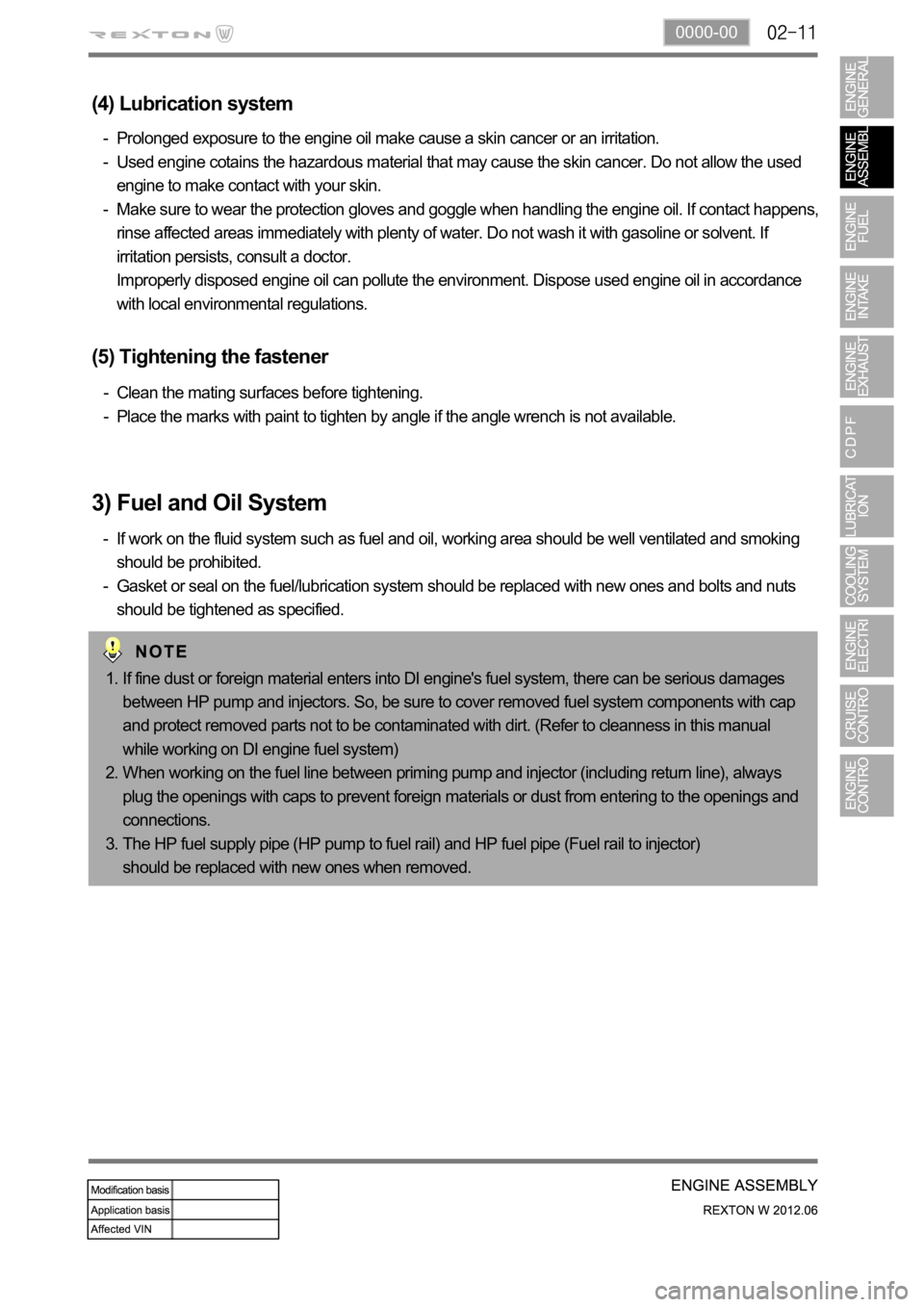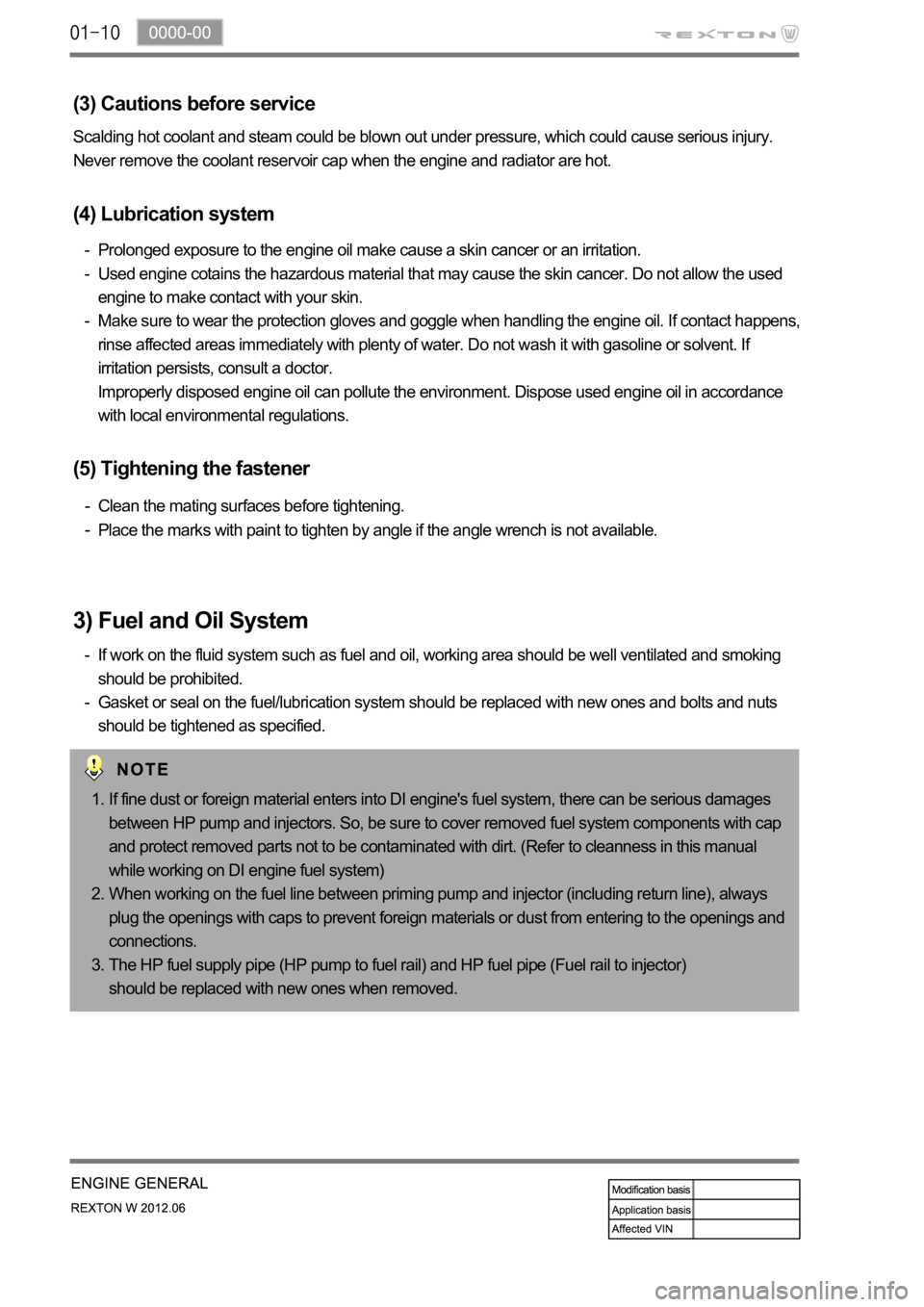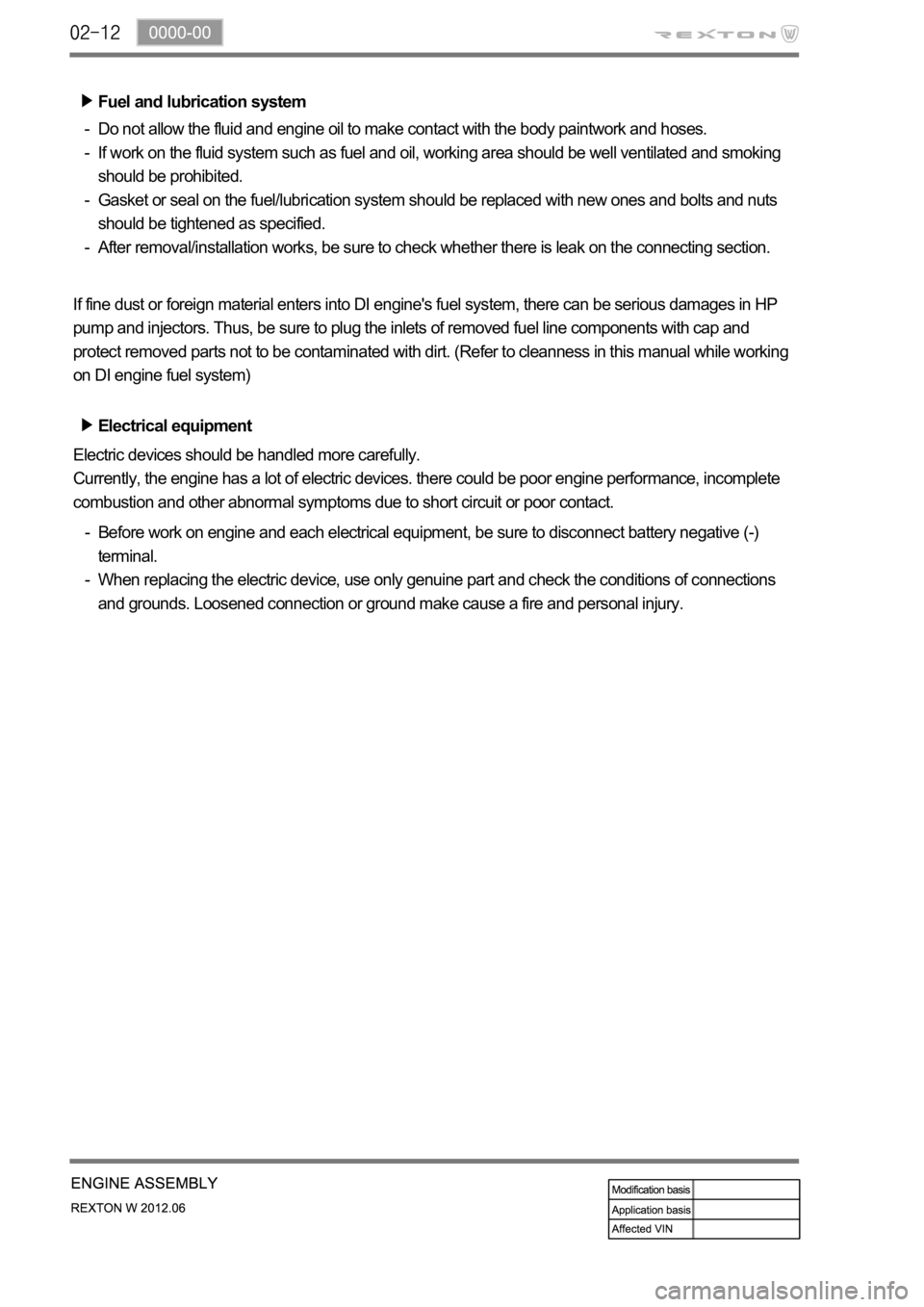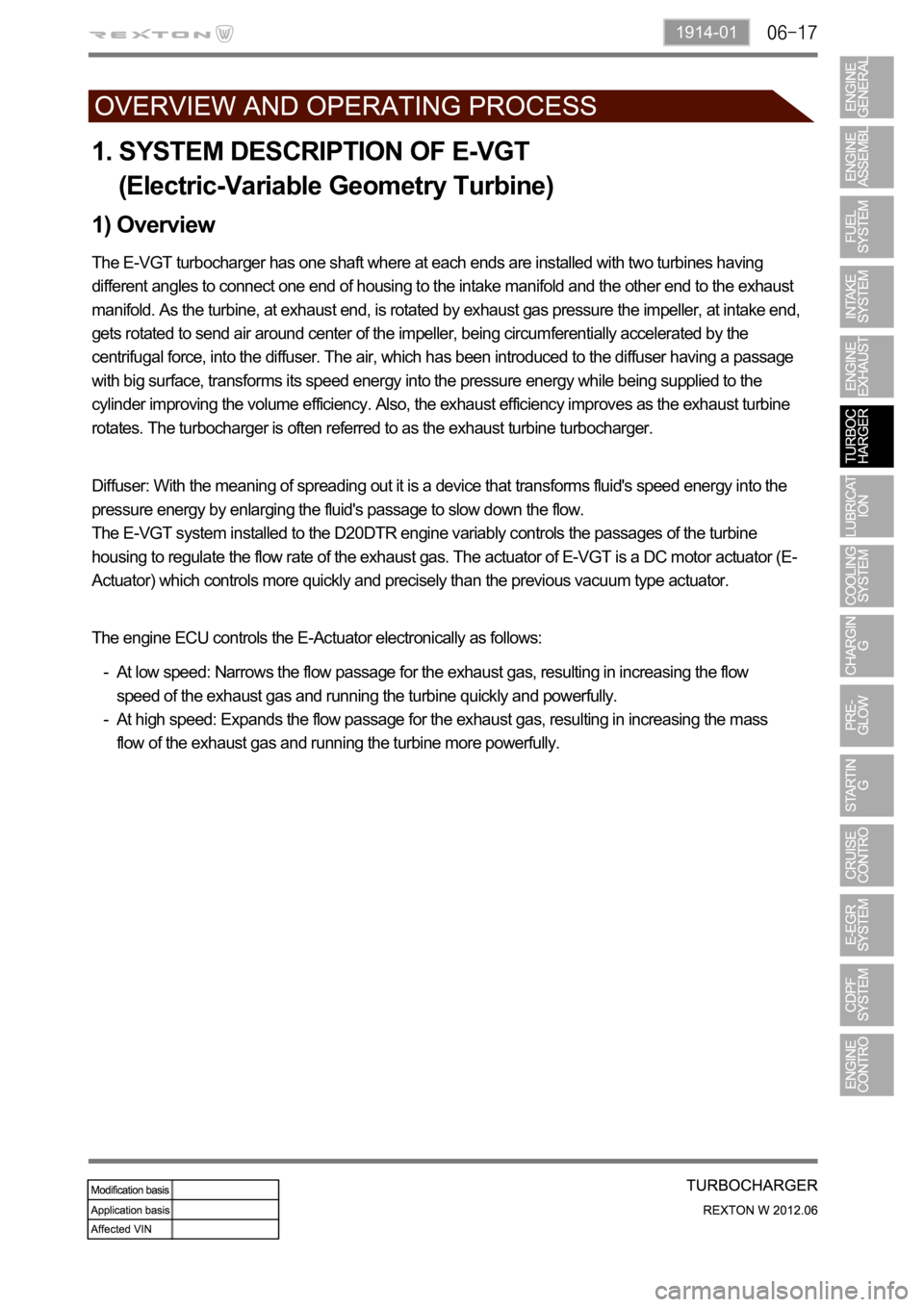2012 SSANGYONG NEW REXTON fluid
[x] Cancel search: fluidPage 145 of 600

VEHICLE GENERAL
1. DIMENSIONS........................................
2. SPECIFICATIONS.................................
3. VEHICLE IDENTIFICATION...................
4. MAINTENANCE ....................................
5. RECOMMENDED FLUIDS AND
LUBRICANTS........................................
6. JACK POINTS.......................................
7. PIN ARRANGEMENT OF DIAGNOSTIC
CONNECTOR........................................
8. ELECTRIC COMPONENTS AND
LAYOUT................................................
9. TIGHTENING TORQUE OF
STANDARD BOLTS...............................3
4
6
7
19
20
21
22
24
Page 163 of 600

0000-00
5. RECOMMENDED FLUIDS AND LUBRICANTS
- Use only Ssangyong recommended fluids and lubricants.
- Keep the specified levels when adding or replacing the fluids.
- Do not mix any different types or brands of oils or fluids. This may cause damages.
D20DTR: Diesel 2.0 (EU5), D20DT: Diesel 2.0, D27DTP: Diesel 2.7 Power-Up,
D27DT: Diesel 2.7, G32D: Gasoline
Page 206 of 600

0000-00
(4) Lubrication system
Prolonged exposure to the engine oil make cause a skin cancer or an irritation.
Used engine cotains the hazardous material that may cause the skin cancer. Do not allow the used
engine to make contact with your skin.
Make sure to wear the protection gloves and goggle when handling the engine oil. If contact happens,
rinse affected areas immediately with plenty of water. Do not wash it with gasoline or solvent. If
irritation persists, consult a doctor.
Improperly disposed engine oil can pollute the environment. Dispose used engine oil in accordance
with local environmental regulations. -
-
-
(5) Tightening the fastener
Clean the mating surfaces before tightening.
Place the marks with paint to tighten by angle if the angle wrench is not available. -
-
3) Fuel and Oil System
If work on the fluid system such as fuel and oil, working area should be well ventilated and smoking
should be prohibited.
Gasket or seal on the fuel/lubrication system should be replaced with new ones and bolts and nuts
should be tightened as specified. -
-
If fine dust or foreign material enters into DI engine's fuel system, there can be serious damages
between HP pump and injectors. So, be sure to cover removed fuel system components with cap
and protect removed parts not to be contaminated with dirt. (Refer to cleanness in this manual
while working on DI engine fuel system)
When working on the fuel line between priming pump and injector (including return line), always
plug the openings with caps to prevent foreign materials or dust from entering to the openings and
connections.
The HP fuel supply pipe (HP pump to fuel rail) and HP fuel pipe (Fuel rail to injector)
should be replaced with new ones when removed. 1.
2.
3.
Page 260 of 600

3. ENGINE COMPARTMENT LAYOUT
Do not work on the engine compartment while the engine, radiator, exhaust manifold, muffler or
catalytic converter is hot. Always turn the engine off and allow it to cool before starting the
maintenance.
Regularly check the engine oil level and add Ssangyong genuine engine oil if necessary.
Clean the dipstick with clean cloth so that any foreign materials cannot get into the engine. -
-
-
Power steering fluid
reservoirBrake fluid reservoir
Fuse & relay
Engine oil dipstick
gaugeWasher fluid
reservoir cap Engine oil filler cap
Air cleaner
Operating vehicle with insuffi cient amount of oil can damage the engine. Make sure the engine oil
level is correct and add oil if necessary.
Coolant reservoir
Battery
Page 264 of 600

(3) Cautions before service
Prolonged exposure to the engine oil make cause a skin cancer or an irritation.
Used engine cotains the hazardous material that may cause the skin cancer. Do not allow the used
engine to make contact with your skin.
Make sure to wear the protection gloves and goggle when handling the engine oil. If contact happens,
rinse affected areas immediately with plenty of water. Do not wash it with gasoline or solvent. If
irritation persists, consult a doctor.
Improperly disposed engine oil can pollute the environment. Dispose used engine oil in accordance
with local environmental regulations. -
-
-
(5) Tightening the fastener
If fine dust or foreign material enters into DI engine's fuel system, there can be serious damages
between HP pump and injectors. So, be sure to cover removed fuel system components with cap
and protect removed parts not to be contaminated with dirt. (Refer to cleanness in this manual
while working on DI engine fuel system)
When working on the fuel line between priming pump and injector (including return line), always
plug the openings with caps to prevent foreign materials or dust from entering to the openings and
connections.
The HP fuel supply pipe (HP pump to fuel rail) and HP fuel pipe (Fuel rail to injector)
should be replaced with new ones when removed. 1.
2.
3. Scalding hot coolant and steam could be blown out under pressure, which could cause serious injury.
Never remove the coolant reservoir cap when the engine and radiator are hot.
(4) Lubrication system
3) Fuel and Oil System
If work on the fluid system such as fuel and oil, working area should be well ventilated and smoking
should be prohibited.
Gasket or seal on the fuel/lubrication system should be replaced with new ones and bolts and nuts
should be tightened as specified. -
-Clean the mating surfaces before tightening.
Place the marks with paint to tighten by angle if the angle wrench is not available. -
-
Page 279 of 600

Electrical equipment
Electric devices should be handled more carefully.
Currently, the engine has a lot of electric devices. there could be poor engine performance, incomplete
combustion and other abnormal symptoms due to short circuit or poor contact.
Before work on engine and each electrical equipment, be sure to disconnect battery negative (-)
terminal.
When replacing the electric device, use only genuine part and check the conditions of connections
and grounds. Loosened connection or ground make cause a fire and personal injury. -
-Fuel and lubrication system
Do not allow the fluid and engine oil to make contact with the body paintwork and hoses.
If work on the fluid system such as fuel and oil, working area should be well ventilated and smoking
should be prohibited.
Gasket or seal on the fuel/lubrication system should be replaced with new ones and bolts and nuts
should be tightened as specified.
After removal/installation works, be sure to check whether there is leak on the connecting section. -
-
-
-
If fine dust or foreign material enters into DI engine's fuel system, there can be serious damages in HP
pump and injectors. Thus, be sure to plug the inlets of removed fuel line components with cap and
protect removed parts not to be contaminated with dirt. (Refer to cleanness in this manual while working
on DI engine fuel system)
Page 355 of 600

2. INSPECTION
1) Cautions During Driving
The following lists cautions to take during test drive and on the turbocharger vehicle, which must be
considered during the operation.
It's important not to drastically increase the engine rpm starting the engine. It could make rotation at
excessive speed even before the journal bearing is lubricated and when the turbocharger rotates in
poor oil supply condition, it could cause damage of bearing seizure within few seconds.
If the engine is running radically after replacing the engine oil or oil filter brings poor oil supply
condition. To avoid this, it's necessary to start off after idling the engine for about 1 minute allowing oil
to circulate to the turbocharger after the replacement.
When the engine is stopped abruptly after driving at high speed, the turbocharger continues to rotate
in condition where the oil pressure is at '0'. In such condition, an oil film between the journal bearing
and the housing shaft journal section gets broken and this causes abrasion of the journal bearing due
to the rapid contact. The repeat of such condition significantly reduces life of the turbocharger.
Therefore, the engine should be stopped possibly in the idle condition. 1.
2.
3.
After string for long period of time during winter season or in the low temperature condition where the
fluidity of engine oil declines, the engine, before being started, should be cranked to circulate oil and
must drive after checking the oil pressure is in normal condition by idling the engine for few minutes.
Page 368 of 600

1914-01
1. SYSTEM DESCRIPTION OF E-VGT
(Electric-Variable Geometry Turbine)
The E-VGT turbocharger has one shaft where at each ends are installed with two turbines having
different angles to connect one end of housing to the intake manifold and the other end to the exhaust
manifold. As the turbine, at exhaust end, is rotated by exhaust gas pressure the impeller, at intake end,
gets rotated to send air around center of the impeller, being circumferentially accelerated by the
centrifugal force, into the diffuser. The air, which has been introduced to the diffuser having a passage
with big surface, transforms its speed energy into the pressure energy while being supplied to the
cylinder improving the volume efficiency. Also, the exhaust efficiency improves as the exhaust turbine
rotates. The turbocharger is often referred to as the exhaust turbine turbocharger.
1) Overview
Diffuser: With the meaning of spreading out it is a device that transforms fluid's speed energy into the
pressure energy by enlarging the fluid's passage to slow down the flow.
The E-VGT system installed to the D20DTR engine variably controls the passages of the turbine
housing to regulate the flow rate of the exhaust gas. The actuator of E-VGT is a DC motor actuator (E-
Actuator) which controls more quickly and precisely than the previous vacuum type actuator.
The engine ECU controls the E-Actuator electronically as follows:
At low speed: Narrows the flow passage for the exhaust gas, resulting in increasing the flow
speed of the exhaust gas and running the turbine quickly and powerfully.
At high speed: Expands the flow passage for the exhaust gas, resulting in increasing the mass
flow of the exhaust gas and running the turbine more powerfully. -
-